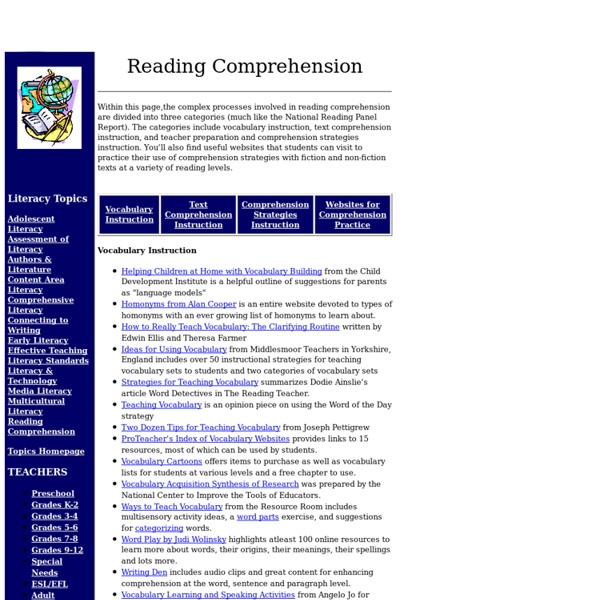



GRE Revised General Test: Reading Comprehension Reading Comprehension questions are designed to test a wide range of abilities that are required in order to read and understand the kinds of prose commonly encountered in graduate school. Those abilities include: understanding the meaning of individual words and sentences understanding the meaning of paragraphs and larger bodies of text distinguishing between minor and major points summarizing a passage drawing conclusions from the information provided reasoning from incomplete data to infer missing information understanding the structure of a text in terms of how the parts relate to one another identifying the author's assumptions and perspective analyzing a text and reaching conclusions about it identifying strengths and weaknesses of a position developing and considering alternative explanations Each Reading Comprehension question is based on a passage that may range in length from one paragraph to several paragraphs.
Reading Comprehension - Phrasing Home > Reading Comprehension > Learning about Phrases to Improve Fluency and Comprehension Learning About Phrases to Improve Fluency and Comprehension by Susan Jones, M.Ed. Even though each word we read or speak has its own meaning, we generally don't read, speak or think of each word by itself. We tend to group words together into phrases. Understanding phrases while reading can help fluency and comprehension. You can make reading in phrases easier by lightly underlining (usually with a slight scoop, as if drawing a spoon to hold the phrase) phrases as you read. Aside from practicing reading in phrases and underlining phrases as you read, there are many written exercises that will develop understanding of phrases. Phrase generation This is a very good exercise for learning to think of words and ideas. 1. Write a question on top of a sheet of lined paper, such as one of the following: What are 25 things you would find in a grocery store? What are 25 kinds of furniture? 2. Sorting exercises:
Literary Terms Poetry Lesson Genre is an important word in the English class. We teach different genres of literature such as poetry, short stories, myths, plays, non-fiction, novels, mysteries, and so on. When we speak about a kind of literature we are really speaking about a genre of literature. So when someone asks you what genre of literature you like, you might answer, poetry, novels, comics, and so on.
Reading Comprehension Learning Tools How Can Reading Comprehension be Taught? If you are like most parents, you have forgotten that you had to develop reading comprehension skill. Much like learning to drive, reading comprehension becomes automatic and skilled readers forget that they had to develop their reading comprehension skill. The key to teaching reading comprehension is developing the habit of “interacting” with the text and monitoring one’s understanding. By “learning to read”, most parents mean that the child is decoding words. Learning reading comprehension requires a strategy where lesson plans progressively develop and reinforce reading comprehension skill. Today, the standardized high-stakes tests, such as the Florida FCAT, the Texas TAKS, the Ohio OGT, and the California Stanford 9 and SABE/2, to name a few, have focused attention by parents and educators on systematic mastering of reading skills. What is reading comprehension? Skilled readers, for instance: Order Now
Strategies for Developing Reading Skills Using Reading Strategies Language instructors are often frustrated by the fact that students do not automatically transfer the strategies they use when reading in their native language to reading in a language they are learning. Instead, they seem to think reading means starting at the beginning and going word by word, stopping to look up every unknown vocabulary item, until they reach the end. Effective language instructors show students how they can adjust their reading behavior to deal with a variety of situations, types of input, and reading purposes. Strategies that can help students read more quickly and effectively include Instructors can help students learn when and how to use reading strategies in several ways. By modeling the strategies aloud, talking through the processes of previewing, predicting, skimming and scanning, and paraphrasing. Reading to Learn Reading is an essential part of language instruction at every level because it supports learning in multiple ways.
Four Roles of a Literate Person Students need to be proficient in four interrelated dimensions of language use. Freebody and Luke (1991) identify the roles literate people take on as: code breaker; text participant; text user; and text analyst. Code Breaker 'How do I crack this code?' This involves being able to decode and encode language at an appropriate level of proficiency. It includes recognising and being able to speak and write words and sentences; it incorporates phonics and the use of accurate spelling and grammar. Text Participant 'What does this mean to me?' Students use their knowledge of the world, knowledge of vocabulary and knowledge of how language works, to comprehend and compose texts. Text User 'What do I do with this text?' Students understand how language varies according to context, purpose, audience and content, and are able to apply this knowledge. Text Analyst 'What does this text do to me?' Read More: Four Resources Model of Literacy
Web English Teacher Reading Comprehension Worksheets Kindergarten Reading Comprehension Here are some very basic passages for students in kindergarten. Each passage is accompanied by several simple reading comprehension questions. 1st Grade Reading Comprehension This page has free reading comprehension passages for students reading at a first-grade level. 2nd Grade Reading Comprehension Here is a collection of articles and stories written for students at a second-grade reading level. 3rd Grade Reading Comprehension Check out our fiction stories, poems, and nonfiction articles written for students reading at a third-grade level. 4th Grade Reading Comprehension Whether you're looking for nonfiction animal articles, biographies on important historical figures, or fun fiction stories, this page has your fourth-grade reading comprehension needs covered. 5th Grade Reading Comprehension We have a large collection of fifth-grade fiction passages, nonfiction articles, and poems. 6th Grade Reading Comprehension Middle School Reading Comprehension